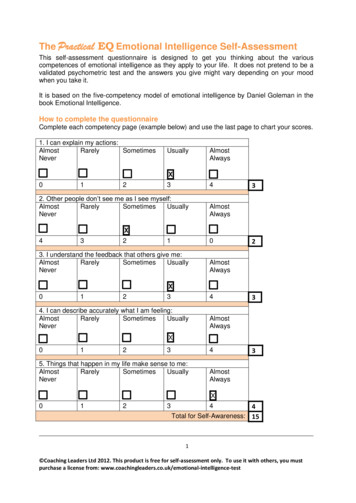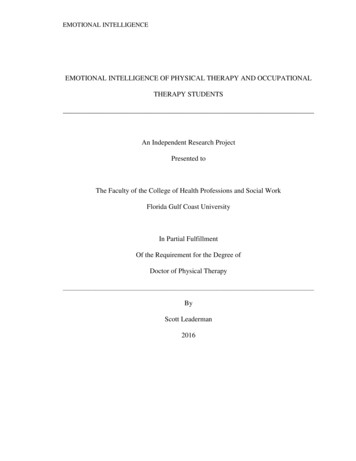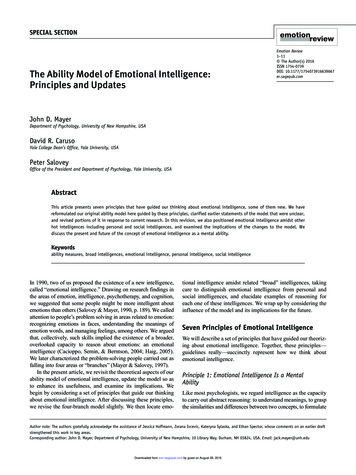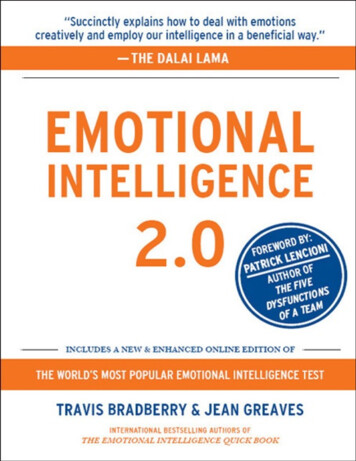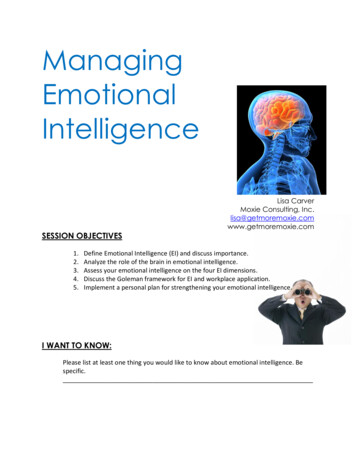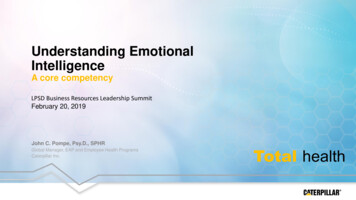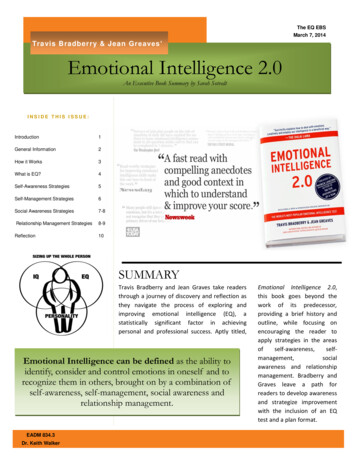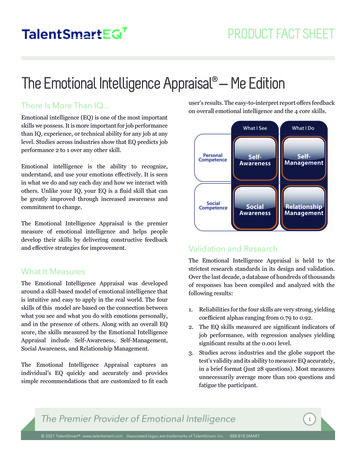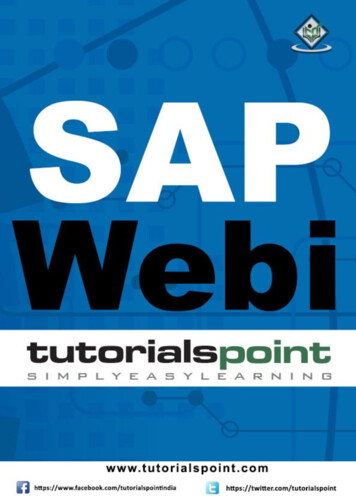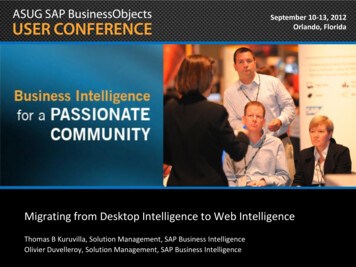
Transcription
This document is provided free of charge for use in your organization.It can not be transferred electronically or resold.AssessingEmotional IntelligenceEmily A. Sterrett, Ph.D.
Copyright 2014 by Emily A. SterrettPublished by:HRD Press, Inc.22 Amherst RoadAmherst, MA 01002800-822-2801ISBN 978-1-61014-313-4Published by HRD Press Inc., 800-822-2801
AssessingEmotional IntelligenceThe purpose of this booklet is to help youimprove your leadership skills by focusing onemotional competencies that affect success inthe workplace and in the world at large. Beforeyou can identify what you need to improve,however, you must know where you are now.This booklet will help you assess your EmotionalIntelligence and then target areas where it canbe strengthened. It concludes with severalpractical suggestions.The checklists that follow have been usedquite successfully with leaders who are engagedin the developmental processes of coaching andtraining in order to improve leadership. Theyare valuable personal tools for managers seeking to gain an understanding of their strengthsand weaknesses in the area of Emotional Intelligence in order to chart a course for personalimprovement and business success.1. Rating EQ: Self-AssessmentThe EQ Self-Assessment Checklist is based onthe six-facet model of Emotional IntelligencePublished by HRD Press Inc., 800-822-28011
Assessing Emotional Intelligenceintroduced in the booklet Defining EmotionalIntelligence (EQ). It will point out to you thosefacets of Emotional Intelligence in which youhave opportunity for improvement.EQ Self-Assessment ChecklistRate each of the following statements by usingthe rating scale below according to how true itis of you.1VirtuallyNever22345VirtuallyAlways1)I am aware of the physical reactions(twinges, aches, sudden changes) thatsignal a “gut reaction.”2)I readily admit mistakes and apologize.3)I let go of problems, anger, or hurts fromthe past and I can move beyond these.4)I generally have an accurate idea of howanother person perceives me during aparticular interaction.5)I have several important things in my lifethat I am enthusiastic about, and I let itshow.Published by HRD Press Inc., 800-822-2801
Assessing Emotional IntelligenceEQ Self-Assessment Checklist (continued)6)I can easily meet and initiate conversationwith new people when I have to.7)I take a break or use another activemethod of increasing energy when I sensethat my energy level is getting low.8)9)I have little trouble taking prudent risks.10)I can engage in an interaction with anotherperson and pretty well size up thatperson’s mood based on nonverbal signals.11)Others usually feel inspired andencouraged after talking to me.12)I have no trouble making presentations infront of groups or conducting meetings.13)14)I take time every day for quiet reflection.15)I refrain from making up my mind on issuesand expressing my opinion until I have allthe facts.I “open up” with people appropriately—not too much but enough so that I don’tcome across as cold and distant.I take the initiative and move ahead ontasks that need to be done.Published by HRD Press Inc., 800-822-28013
Assessing Emotional IntelligenceEQ Self-Assessment Checklist (continued)16) I have a number of people I can turn to,and I ask for their help when I need it.17) I try to find the positive in any givensituation.18) I can deal calmly, sensitively, andproactively with the emotional displays ofothers.19) I can usually identify the emotion I amfeeling at any given moment.20) I am generally comfortable in newsituations.21) I neither bury my anger nor let it explodeon others.22) I can show empathy and match myfeelings with those of another person inan interaction.23) I can keep going on a big project, despiteobstacles.24) I am respected and liked by others, evenwhen they don’t agree with me.25) I am clear about my own goals and values.26) I express my views honestly andthoughtfully, without being pushy.4Published by HRD Press Inc., 800-822-2801
Assessing Emotional IntelligenceEQ Self-Assessment Checklist (concluded)27) I am good at managing my moods, and Iseldom bring negative emotions to work.28) I focus my full attention on anotherperson when I listen to him or her.29) I believe the work I do day-to-day hasmeaning and value to society.30) I can effectively persuade others to adoptmy point of view without coercing them.Published by HRD Press Inc., 800-822-28015
Assessing Emotional IntelligenceScoring the EQ Self-Assessment Checklist1. Enter your ratings for each numbered question in the category where it appears.2. Add the ratings for each category to obtain atotal for that specific facet of EQ.Self-Awareness6Empathy14710131619222528Total Self-Awareness:Total Total Self-Confidence:Total Motivation:Published by HRD Press Inc., 800-822-2801
Assessing Emotional IntelligenceSelf-ControlSocial Competency36912151821242730Total Self-Control:Total SocialCompetency:Interpreting the ScoreYour score on each of the six facets will fallsomewhere between 5 and 25 points. Circle anyfacet where your score was below 20: this indicates an area that you can improve. Your overallEmotional Intelligence will improve as you workon that particular area.Other opportunities for improvement canbe found in any individual question from thechecklist on which you scored a 4 or below. Circle those questions; a rating of 3 is average, butif you have Emotional Intelligence, you areabove average. So you need to target that areafor improvement and turn it into a specific goal.Effective leaders are generally high in all sixareas. If you want your career and your relationships to soar, think of this booklet as a workPublished by HRD Press Inc., 800-822-28017
Assessing Emotional Intelligencebook, and make a commitment to do somethingto improve your weaknesses each day. Ideas forimprovement in personal/self areas can befound in The Role of Self-Awareness in Emotional Intelligence, The Role of Self-Confidence inEmotional Intelligence, and The Role of SelfControl in Emotional Intelligence.Obtaining Feedback from OthersOther people have much to teach us about ourselves. Examining our own behavior is crucial,but while most of us know our own strengthsand weaknesses reasonably well, there arecountless little things of which we are oftenunaware. The way other people perceive us hasa great deal to do with how effective we are inany interaction, and we can’t know for sure howwe are coming across unless we ask for feedback. Hearing the observations of others withwhom we interact will increase our self-awareness. The checklist on page 10 will assist you inobtaining feedback.8Published by HRD Press Inc., 800-822-2801
Assessing Emotional Intelligence2. Rating EQ: Leadership AssessmentThe Leadership Assessment Checklist is also agood source of information for personal growth.It is often helpful to compare the way we rateourselves and the way others rate us on the verysame items, but other people can only indirectlyassess our “Self” competencies. They can, however, judge us fairly accurately in terms of socialand leadership skills. The questions on the listthat follows are different from the Self-Assessment Checklist: the Leadership AssessmentChecklist pertains to such EQ competencies asempathy, motivation, optimism, and social competency, as well as leadership and team-buildingskills such as employee empowerment, feedback, and conflict-resolution, described in TheRole of Empathy in Emotional Intelligence,Motivation and Emotional Intelligence, andSocial Competency and Emotional Intelligence,and especially in Promoting Emotional Intelligence in Others: Developing an Employee andPutting Emotional Intelligence to Work: TheTeam. Give copies of the checklist to peers andassociates, employees, friends, supervisors, yourmentor, and to anyone else who can provide asnapshot of your behavior to help increase yourself-awareness. Make sure they have a place toreturn this easily and anonymously, and givethem a deadline date.Published by HRD Press Inc., 800-822-28019
Assessing Emotional IntelligenceLeadership Assessment ChecklistPlease rate(insert your name) on each of the followingstatements by using the rating scale below.1VirtuallyNever2345VirtuallyAlways1) Stands behind employees, backing theirdecisions and advocating for them tohigher management.2) Knows how to delegate tasks but remainsavailable for consultation.3) Takes disciplinary action promptly andfairly, without being overly harsh ordemeaning.4) Sets high performance standards for selfand subordinates.5) As soon as he/she is aware of a problem,sits down with a subordinate who has notmet expectations, coaches them, andworks with them to perform better.6) Provides frequent feedback to employeeson how they are doing their job.7) Uses more praise and positive feedbackthan negative feedback.10Published by HRD Press Inc., 800-822-2801
Assessing Emotional IntelligenceLeadership Assessment Checklist (cont’d.)8) Refrains from letting some employees getaway with less effort than others.9) Can persuade others to adopt his/herpoint of view without coercion.10) Makes positive use of conflict by encouraging discussion of differing points ofview.11) Keeps employees informed at all timesabout things that might affect them.12) Takes the long-term view, without gettingtoo focused on strictly short-term results.13) Listens well and shows empathy andconcern when I have a problem.14) Has an open-door policy and makeshimself/herself available to the staff whenneeded.15) Refuses to tolerate bigotry or narrowmindedness among the staff.16) Helps employees discover their ownsolutions, without automatically providinganswers.17) Keeps conflict among employees fromfestering or getting out of control, andinstead works to reach a commonunderstanding.Published by HRD Press Inc., 800-822-280111
Assessing Emotional IntelligenceLeadership Assessment Checklist (concluded)18) Tries to be patient with staff when implementing a change, knowing that there isan adjustment period.19) Actively looks for ways to challenge anddevelop all workers.20) “Opens up” to others appropriately—nottoo much, but enough to assure them thathe/she is not cold and distant.12Published by HRD Press Inc., 800-822-2801
Assessing Emotional IntelligenceUsing Your Leadership AssessmentChecklist ResultsCalculate an average score on each question byaveraging all responses on each of the 20 questions. For example, if you received five completed checklists, calculate an average for thefive on Question 1, Question 2, etc. Pay particular attention to any question with a rating of lessthan 4.0. The further it is under 4, the greaterthe need for work in that area. Make this a personal developmental goal for your own career.In addition, examine individual questionsfrom individual raters where you scored lowerthan 4. Perhaps some people believe that you doneed work in that area. Again, this is helpfulinformation and guides you as you develop personal goals.Setting Personal GoalsBased on the assessment you performed onyourself and the feedback you obtained fromothers, what three goals would you most like toconcentrate on for your personal and professional leadership development as they pertain toEmotional Intelligence? Write those on the following page.Published by HRD Press Inc., 800-822-280113
Assessing Emotional IntelligenceGoals for Personal and ProfessionalLeadership Development1.2.3.14Published by HRD Press Inc., 800-822-2801
Rating EQ: Self-Assessment The EQ Self-Assessment Checklist is based on the six-facet model of Emotional Intelligence . 1 . Published by HRD Press Inc., 800-822-2801. Assessing Emotional Intelligence . introduced in the booklet . Defini

